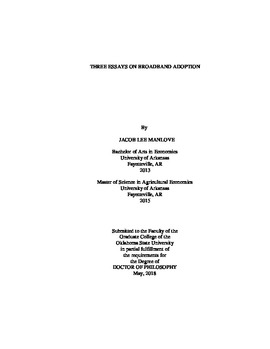| dc.contributor.advisor | Whitacre, Brian | |
| dc.contributor.author | Manlove, Jacob Lee | |
| dc.date.accessioned | 2019-03-25T21:59:31Z | |
| dc.date.available | 2019-03-25T21:59:31Z | |
| dc.date.issued | 2018-05 | |
| dc.identifier.uri | https://hdl.handle.net/11244/317766 | |
| dc.description.abstract | This dissertation focuses on three issues surrounding broadband internet adoption. The first study examines the recent shift to mobile-only internet connections. The percentage of mobile-only households increased from 9% in 2011 to 20% in 2015, more than doubling in only four years. As this shift continues, it leads to the question of what factors are driving the rise in mobile-only adoption. Using nationally representative data, this study uses logistic regressions and a decomposition technique to understand the trend. The decomposition reveals that a significant portion of the growth was due to an increase in the download speeds of mobile networks. An increased acceptance of mobile-only access by households aged 55 and older was also partly responsible. Understanding (and developing a response to) the trend towards mobile-only adoption will be important as organizations and governments continue to work to close the digital divide. | |
| dc.description.abstract | The second study examines the effectiveness of a well-known grassroots broadband adoption oriented program, Connected Nation. While a large number of studies have examined policies and programs aimed at increasing infrastructure, little analysis to date has focused on evaluating efforts to increase adoption. This analysis focuses on the effectiveness of Connected Nation's efforts by evaluating its impact on adoption rates using a generalized difference-in-difference methodology. While the results indicate there was no significant initial impact, there is evidence of a linear effect resulting in increased adoption 2 to 4 years after the program began. This paper represents a rigorous evaluation of one of the most well-known adoption-oriented programs, and emphasizes that effective use of broadband funds should include empirical analysis of what woks. | |
| dc.description.abstract | The third study examines the need for a measure of inequality for broadband adoption. Broadband adoption is primarily measured as the percentage of a population with a connection, regardless of the modality used (i.e. fixed, mobile, or both). This results in a binary measurement that distinguishes between two groups: the percentage that have the defined level of access and those that do not. However, this measure fails to capture differences that may exists in ow users connect - for example, those who use both mobile and fixed versus those use mobile only. This article proposes the use of the absolute value index (AVI) as a measure to study broadband adoption inequality. Using nationally representative data, adoption is broken into four types of connections (none, mobile, fixed, both) to compile the AVI. This measure of inequality may better represent the disparities associated with broadband use across the country, particularly as mobile internet use rises. The results indicate that the AVI can be useful in differentiating adoption patterns (i.e. mobile vs. fixed) in states with similar aggregate levels of adoption. Two nonnested hypothesis tests formally explore the explanatory power of the two measures in explaining economic relationships commonly associated with broadband adoption, and conclude that the AVI does not capture any additional information. | |
| dc.format | application/pdf | |
| dc.language | en_US | |
| dc.rights | Copyright is held by the author who has granted the Oklahoma State University Library the non-exclusive right to share this material in its institutional repository. Contact Digital Library Services at lib-dls@okstate.edu or 405-744-9161 for the permission policy on the use, reproduction or distribution of this material. | |
| dc.title | Three essays on broadband adoption | |
| dc.contributor.committeeMember | Stoecker, Art | |
| dc.contributor.committeeMember | Shideler, Dave | |
| dc.contributor.committeeMember | Malone, Chad | |
| osu.filename | Manlove_okstate_0664D_15675.pdf | |
| osu.accesstype | Open Access | |
| dc.type.genre | Dissertation | |
| dc.type.material | Text | |
| thesis.degree.discipline | Agricultural Economics | |
| thesis.degree.grantor | Oklahoma State University | |
